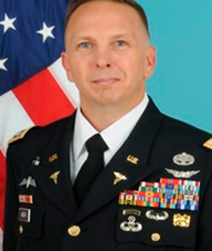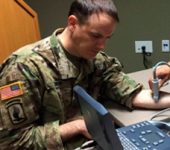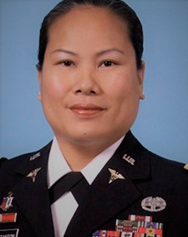
The physician assistant (PA) profession began as an effort to simultaneously address two Vietnam War-era problems: 1) highly skilled combat medics returning home without a specific title or skill set readily translatable to a civilian career, and 2) a significant physician shortage during a high-casualty conflict. The PA concept that began in the late 1960s thus held great promise for its original students and the military, as well as a larger civilian population seeking advanced medical care. In 1967, the first class of PAs completed their training and were awarded certificates by Duke University. While all military services (Army, Navy, Air Force, and Coast Guard) have conducted PA training since 1971, the Army has trained and retains the largest number of PAs in the Department of Defense (DoD) throughout this time [1]. Similarly, as the PA profession celebrated its 50th anniversary in 2017, historical reflection shows increasing depth and breadth of PA practice, both within and outside the Army.
Army PA training provided an associate degree from Baylor University with its first graduation class in 1973 but was raised to a baccalaureate in 1983 through the University of Oklahoma [2]. Commensurate with the high level of training, certification was elevated again in 2003, this time to a master’s degree through the University of Nebraska [3]. Currently, the Interservice Physician Assistant Program (IPAP) consolidates all didactic PA training across DoD at JBSA-Fort Sam Houston, Texas, at the Army Medical Department Center & School Health Readiness Center of Excellence (AMEDDC&S HRCoE). While IPAP has been noted to be the largest PA training program in the world, the Army contributes by far the largest percentage of students [1].
The Army also developed the Long Term Healthcare Education Training (LTHET) program, an initiative primarily aimed toward advanced training in emergency medicine, orthopedics, and surgery, which as of publication is one of only a few advanced PA training programs in the world to award a doctorate in science (DSc) upon completion. LTHET similarly offers advanced degrees for healthcare administration, education, epidemiology, and dietetics. PAs have also increased contributions to medical research and investigative study.
With the expansion of education and advanced practice opportunities in the Army, PAs have also been part of tremendous growth in both medical and overall force leadership. In 1973, PAs were appointed as warrant officers upon training completion, thus enabling them as specialists and advisors to commanders but unable to lead in command positions as commissioned officers. This changed when the US Army began to commission warrant officers in the 1980s and then again in 1992 when PAs began to segue into fully commissioned officers [3]. Commissions enabled PAs to take commands and earn new levels of leadership. PAs notably began to serve as commanders and directors, and to lead medical units. PAs have held Battalion Command, taken charge of clinics, and, notably in 2017, were selected as head of the Army Medical Specialist Corps [4].
As the PA profession begins its 51st year, the first Borden US Army Physician Assistant Handbook was published in May 2018 and a cohort of senior leaders, both active duty and prior service, were interviewed for their personal reflections on the inception, growth, and importance of the Army PA position. Their answers provide significant insight into the roots and future of Army PAs in active service, and in transition to civilian medical practice.
Memories of the Beginning
Major (Retired) Scott Gilpatrick is a 25-year Army veteran with deployments in Panama, Haiti, Afghanistan and Iraq, including positions as US Special Operations Command (USSOCOM) PA and Regimental PA for the 75th Ranger Regiment and 160th Special Operations Aviation Regiment (SOAR). He began his Army career in the late 1980s and says, “We all knew the Battalion PA as the salty wizard-like Warrant Officer who was always the last word in all things medicine. They were role models, teachers, mentors, and parental figures who made us (Army medics and GMO physicians) what we are today.”
“But that was all. There was no clear progression beyond the Battalion, much like a pilot who flew the same helicopter until he retired as a CW4 or CW5,” continues MAJ(R) Gilpatrick, who currently works as lead advanced practicing clinician (APC) at Midtown Medical Center Pediatric Emergency Department, as well as serving as Tactical Medical Officer for the Columbus, Ga., Police Department SWAT Team.
“A big challenge for us was that AMEDD (Army Medical Department) didn’t see us as potential leaders. Commissioning changed that. When we began staying beyond 20 years, we began getting promoted to Major and then Lieutenant Colonel, and were treated differently,” explains Colonel (Retired) Gross, an Army PA for more than 30 years. After 44 years of total Army service, COL(R) Gross retired after most recently serving as Installation Management Command (IMCOM) Surgeon at JBSA-Fort Sam Houston, Texas. She has deployed to Honduras, Iraq and Afghanistan, and was the first PA assigned to US Army Recruiting Command and first female PA Career Manager/Assignments Officer.
According to Colonel Robert Heath, a 30-year Army veteran with a 1989 combat parachute jump into Panama with the 75th Ranger Regiment, as well as deployments as a PA to Iraq and Afghanistan, and specialty training in orthopedics, “Army PAs then moved from a technical medical specialist to professional Army officers in the Profession of Arms.” COL Heath is currently serving as Director, Military Health System Governance, and Defense Health Agency (DHA) Liaison for the Army at the Office of the Surgeon General in Falls Church, Va.
“The pace at which our community has grown to accommodate the ever-changing demands of our warfighter environment throughout the past two decades has been astounding,” explains Major (Retired) Jonathan Monti, EMPA. MAJ(R) Monti has 17 years of service as an Army PA, including multiple deployments to Iraq and Afghanistan, with a combat parachute jump into Iraq in 2003. He is currently designing and conducting research involving combat medic use of ultrasound with the Henry M. Jackson Foundation for the Advancement of Military Medicine. His last position was Director of Madigan Army Medical Center’s Emergency Medicine PA Residency Program, where he was also named the inaugural Society of Emergency Medicine PAs (SEMPA) EMPA of the Year in 2017.
“Traditionally we were bringing in people with combat medic experience. Now we are also bringing in others with varying experiences, such as leadership and non-medical backgrounds (Field Artillery, Engineers, Medical Service Corps are just a few examples),” explains Lieutenant Colonel (Promotable) Amy Jackson, an Army veteran for more than 25 years, Army PA for more than 13 years, including prior enlisted service and Medical Service Corps Officer. She is currently serving as Deputy Commander for Administration (DCA), Supreme Headquarters Allied Powers Europe (SHAPE) Clinic, Belgium. She has deployed to Iraq and Afghanistan, and was Human Resource Command 65D (PA) Assignment Officer, Director for Medical Services at the DiLorenzo Clinic at the Pentagon, and first Battalion Commander of the 188th Medical Battalion, JBSA-Fort Sam Houston, Texas.
“Because of our two primary roles of providing direct primary and battlefield care, and training combat medics, we are now arguably the most vital and valuable medical MOS (Military Occupational Specialty) to our frontline warfighters in the provision of their healthcare,” says MAJ(R) Monti.
Benefits of a Military Background
“PAs with a military background possess a familiarity with soldiering (the daily tasks, physical requirements per MOS, etc.) that allows them to consider well how their medical management plans can best be implemented for an individual, within the constraints of a unit,” explains MAJ(R) Monti.
“They don’t have to worry as much about learning to be in the Army,” comments COL Heath.
MAJ(R) Monti believes this “allows them to best implement preventive medicine and readiness plans to ensure commanders have the fighting force they need.”
Lieutenant Colonel (Promotable) John Detro, a 30-year Army veteran, who completed PA school in 1997 explains, “Both groups (prior enlisted and prior officer) bring strengths and weaknesses. We get the best of both worlds with those who have commissioned and enlisted time together. Prior commissioned and prior enlisted in a Battalion and Brigade make for a powerful combination.” LTC(P) Detro most recently served as the Army Surgeon General’s PA Consultant and as Commander, 187th Medical Battalion, JBSA-Fort Sam Houston, Texas, and is now Director of Talent Management at Human Resource Command, Fort Knox, Ky. He has deployed to Iraq and Afghanistan, and held numerous positions like Battalion PA for 3rd Battalion, 75th Ranger Regiment, Squadron PA with Joint Special Operations Command, and Chief, Surgical Services Service Line (3SL), Office of the Surgeon General.
The majority of Army physicians are no longer primary care-based; their focus is on specialty care. We are deploying these specialists, who may better serve the Army, at home station or within Combat Support Hospitals.
PAs vs. Physicians as Unit-level Medical Providers
COL Heath says most physicians are PROFIS (Professional Filler System) and, therefore, they do not regularly interact with unit commands. By comparison, explains MAJ(R) Gilpatrick, “The PA, who’s with the battalion daily – training, treating and interacting with their Soldiers – will distinguish themselves more often as leader and mentor.” According to COL Heath, this helps earn the trust of the unit.
“Walking the walk and talking the talk is what validates any provider with their unit,” says Colonel John Balser, a 30-year Army veteran with prior service as a combat medic. COL Balser is currently serving as Army Specialist Corps Chief and Military District Washington (MDW) Command Surgeon, JTHQ-NCR, Washington, DC. He completed PA school in 1990, and subsequently completed orthopedic specialty training in 1996. He has deployed to Iraq and Afghanistan, and held multiple positions, including Deputy Commander for Operations, Craig Joint Theater Hospital in Bagram, Afghanistan, and Command Surgeon, Army Reserve.
LTC(P) Detro comments: “PAs are unique amongst AMEDD especially as the PA-Medic team is the first line of care that Soldiers see in garrison and combat. Physician PROFIS bring unique perspectives depending on their specialty. They have skill sets that may be valuable downrange but usually lack experience in operational medicine, staff work, and briefing commands. The majority of Army physicians are no longer primary care focused; their focus is on specialty care. We are deploying these specialists, who may better serve the Army, at home station or within Combat Support Hospitals.”
Expansion of Health Delivery
According to MAJ(R) Monti, experienced PAs know well the potential that exists that either they, or their medics, could be the only healthcare provider available to a group of Soldiers in an austere location. And combat medics are the extensions of PAs.
LTC(P) Jackson explains, “They are running the show for us, and we are responsible for training them on their clinical and battlefield competencies. Medics enhance Armed Forces readiness, clinical productivity, Access to Care, and serve as the first contact for our patients. Therefore, they play an integral role in the Patient Centered Medical Home (PCMH) and Soldier Centered Medical Home (SCMH).”
“There is a unique focus on not only the PA being trained on TC3 (tactical combat casualty care),” comments LTC(P) Detro, “but also training our medics to treat common conditions downrange, emergency conditions, and those diseases seen within specific geographic environments. They must also be able to identify critical conditions, which may require the patient to be seen by a higher level of health care provider through evacuation.”
MAJ(R) Monti says, “The best PAs, in my humble opinion, consider this the most important aspect of their job.”
Comparison of Military to Civilian Programs
COL(R) Gross says it is difficult to compare a program that graduates 60-80 PAs every four months with a 97-100 percent (national certification) pass rate. She explains, “The Reservist and National Guard PAs upon graduation are sought out for hire based on IPAP reputation.”
COL Heath concurs, “IPAP continues to be one of the top performing PA programs in the nation. Selection processes ensure motivated, quality, mature candidates. The program also delivers an experiential learning environment that cannot be duplicated in civilian programs.”
“In my current role as civilian lead PA in a busy Emergency Department, I precept and mentor PA students, NP students, medical students and family medicine residents. I also interact with local Army PA students at Ft. Benning, and the focus, work ethic and medical knowledge can’t be matched by any of the civilian students I precept. It’s truly a testament not only to the program but also to the general military Soldier mindset,” says MAJ(R) Gilpatrick.
Advanced Training Opportunities
LTC(P) Jackson believes the primary advanced training opportunity is the Long Term Health and Education Training (LTHET) “where we have our Army-Baylor Doctor of Science Program in Emergency Medicine, Orthopedics and General Surgery. We now also have several programs in Doctors of Philosophy (PhD), Informatics, RAND, and the Army-Baylor MBA/MHA, as well as Training with Industry (TWI) at NCCPA (National Commission on Certification of Physician Assistants) and AAPA (American Academy of PAs).”
LTC(P) Detro considers flight medicine, dive medicine, and the Masters in Occupational Health to be great advanced training opportunities. He continues, “We have other PAs that expand their skill sets through leadership training, such as pre-command courses, the AMEDD Executive Skills Course, and programs of that nature. Army PAs are also expanding their expertise by teaming up with civilian organizations like the National Football League (NFL) to research and develop best practices regarding care of traumatic brain injuries (TBI) and musculoskeletal injuries.”
“I think what I see most is advanced training in new technology. Training in the use of ultrasound, telemedicine, electronic peripheral brains and references is what certainly brings more advanced and a higher level of medicine far forward,” comments MAJ(R) Gilpatrick.
Advanced Training Benefits
“The Army has a physician shortage in Emergency Medicine, Orthopedics, and General Surgery, which means there are fewer to deploy when and where needed. Having PAs with the above education would expand the capabilities of medical teams, provide oversight and training to deployed PAs and their medics, and free up MD specialists to take care of the most serious patients,” explains COL(R) Gross.
LTC(P) Detro says, “The EMPA program provides PAs with increased capabilities in providing improved battlefield DCR (damage control resuscitation). We are currently exploring substitution of Orthopedic PAs for Orthopedic Surgeons on FRSTs (Forward Resuscitative Surgical Teams) and ERST-As (Expeditionary Resuscitative Surgical Teams-Africa) to decrease the deployment OPTEMPO for surgeons while bringing providers onto the team with advanced operational planning and survival skills. Everybody wants PAs and to allocate positions for them. We are looking to expand by working with other consultants to determine the greatest needs for our services within brick and mortar medical treatment facilities. We are also in communication with other services, such as Canadians and British, looking into expanding our partnerships, to include training with coalition partners.”
“These are top-tiered programs,” explains COL Balser, “that provide training well above what other programs can provide, so I think the natural evolution will see this expand into the mainstream. There is international interest in these programs given that other countries have seen our PAs perform in austere environments – so we have set the bar.”
LTC(P) Jackson comments, “If we put a PA in any subspecialty training, we increase Access to Care for the Warfighter, Soldiers for Life, and family members.”
The Army has always demanded more of its PAs than is typical in the civilian sector, says MAJ(R) Monti, who explains, “Additionally and often overlooked, the research components of these programs allow attendees the opportunity to design and execute high-quality research, which can greatly impact the care our Soldiers receive in garrison and on the battlefield. This is a vital component to ensuring we remain on the cutting edge of healthcare and battlefield medical care. Employment of new techniques, such as walking blood donor drives, point-of-care ultrasound, and novel pain management techniques, are a few examples of how PAs are advancing battlefield medicine.”
LTC(P) Detro believes this is currently an underserved research environment. He comments, “DSc-trained PAs can better employ research to actually collect data on what is currently mainly anecdotal evidence, turning this information into known data sets that can be analyzed to improve clinical outcomes.”
“The years of being deployed and suffering through training rotations, having to scrounge supplies, McGyver medical equipment, rely on stethoscopes and BP cuffs, examine Soldiers with a headlamp, resuscitate in a truck or helicopter – knowing the person you worked on – have certainly enabled me to practice better medicine in a warm, clean and well-stocked ER.”
Career Expansion in Medical Leadership
“We were previously trying to fill foxholes,” says LTC(P) Jackson, “and we were not able to go outside of our own positions. Now we have PAs who are competing and doing really well. A few examples are COL Jeffrey Oliver’s position as Special Assistant to the Director of the Army Staff (DAS) at the Pentagon and LTC James Jones at the White House, where they named him communications agency director. He was instrumental in expanding our personnel authorizations there. MAJ Saibatu Mansaray-Knight was Vice President Biden’s Aide. As the recent commander of the 188th Medical Battalion, I wanted to be able to apply my medical and clinical knowledge in leadership positions and non-clinical roles.”
MAJ(R) Gilpatrick believes the Army/Soldier experience a PA brings to the table makes them a natural for leadership roles. Heath concurs and explains that Army PAs are now serving as Commanders at the Battalion, Brigade, and Military Treatment Facility (MTF) levels. They additionally serve in MTF executive leadership positions (Deputy Commander, Deputy Commander for Administration, Deputy Commander for Clinical Services, etc.). Army PAs also serve in high-level Key Strategic Billets at the Army, DoD, Congressional, and interagency levels.
“We are now competing and being selected for unique assignments to improve leadership roles throughout Army Medicine,” says LTC(P) Detro. “We have Deputy Commanders for Administration (DCAs), commanders, service line leaders, and others serving in unique roles providing them with broadening assignments to move to advanced roles in Army Medicine.”
Better Medicine in a Civilian Environment
“Delivering healthcare as an Army PA in all types of scenarios and locations across the globe has instilled a level of confidence that I can deliver quality healthcare anywhere regardless of the conditions,” explains COL Heath.
LTC(P) Detro says, “Civilian providers are surprised by the independence of military PAs – what we can do. They are surprised that we jump in and get our hands dirty compared to civilian-trained PAs.”
“I owe my success and have saved lives with my military experience in the civilian setting. I am an effective leader and communicator because of the Army. The years of being deployed and suffering through JRTC (Joint Readiness Training Center, Fort Polk, La.) and NTC (National Training Center, Fort Irwin, Calif.) rotations, having to scrounge supplies, having to McGyver medical equipment and procedures, relying on stethoscopes and BP cuffs, examining Soldiers with a headlamp, resuscitating in a truck or a helicopter, knowing the person you worked on who is critically wounded or has died, have certainly enabled me to practice better medicine in a warm, clean and well-stocked ER,” explains MAJ(R) Gilpatrick.
MAJ(R) Monti comments: “The stressors associated with solely managing multiple combat casualties on a remote, forward operating base or multiple, critically ill patients in an emergency department are not easily duplicated elsewhere. Army PAs are generally considered highly capable, resilient, decisive, and adaptive to the ever-changing environments in which they often find themselves. These qualities are highly sought after in the civilian sector. Such uniquely challenging situations often serve to instill unwavering confidence in their abilities, no matter how difficult the practice environment they should find themselves in the future. Personally, expertise gained through the Army’s emergency ultrasound fellowship program has allowed me the opportunity to become a nationally recognized instructor and influential proponent of non-physician, point-of-care ultrasound as it rapidly expands into civilian PA practice.”
The US Army Physician Assistant Handbook
The original concept for the first Army PA Handbook came from LTC(P) Jackson. In 2009 while serving as a battalion PA with the 101st Airborne Division as a newly promoted major, she recognized her own knowledge gap, unsure of what a PA career path entailed after completing battalion PA time. As a previous Medical Service Corps officer, she had many mentors and leaders who helped her find and understand the path she would take as a medical logistician. From this experience, LTC(P) Jackson came to believe that leadership, mentors, and information sharing are vital to the success of Army PAs.
In 2013, LTC(P) Jackson contacted the Borden Institute (BI) about publishing a handbook for PAs. Established in 1987, BI fosters and promotes excellence in military academic medicine through development and publication of military medical scholarship, and is currently located at Ft. Sam Houston, Texas. LTC(P) Jackson initially spoke with 20 of her fellow senior PA colleagues and identified key PA roles, accomplishments, and highlights of Army PA history – areas she believed were important to Army PA professional development. As the project progressed, she collaborated with LTC Amelia Duran-Stanton, who was then Deputy Chief of Inspections at MEDCOM IG (US Army Medical Command Inspector General). LTC Duran-Stanton became senior co-editor, and together, she and LTC(P) Jackson reviewed and refined input received from dozens of Army PAs.
“The Army PA has evolved significantly since the first graduates in 1973. As with the first civilian PAs, we were initially looked upon as assistants/technicians,” explains COL(R) Gross. “Due to a shortage of physicians, the Army PA became the primary medical providers at the unit level, taking on additional duties and responsibilities initially through necessity. As we proved we were capable, the PA became the go-to person. With commissioning, opportunities slowly opened up, positions opened that were previously only for other AMEDD officers. The handbook illustrates this history throughout.”
COL Heath explains, “The Army PA handbook itself epitomizes the strength and evolution of Army PAs whose origins have been ‘from the line, for the line.’ As the mission and opportunities evolve, Army PAs continue to push far forward while always reaching back with lessons learned to bring others forward. This first US Army PA Handbook is a testament to that legacy and to the spirit of all Army PAs – past, present, and future.”
“The book is designed to provide an understanding of where the Army PA came from, where we are today, and where we are headed in the future while providing a description of just about every potential position a PA could serve,” says LTC(P) Detro. “In many cases, there have been one or two PAs who blazed a trail within various duty positions. The chapters within the book provide insight into this expansion of PA roles while also providing a trajectory of where PAs are headed in the future.”
LTC(P) Jackson concurs, “The Army PA Handbook is a legacy to those who have served, who continue to serve, and to those who will follow us. It highlights our history and our fallen, who gave the ultimate sacrifice while serving as a PA. It provides a foundation for mentoring moments to help PAs chart their own paths while fully understanding the evolution of the PA role and our notable contribution to Army Medicine.”
A Bright Future
“The PA profession started with the military, and we continue to provide new and exciting avenues to advance. The future is still unwritten, and I am proud to be a part of such a dynamic group of individuals,” says COL Balser.
LTC(P) Detro explains that the future of the Army PA is bright, “We are gaining end-strength, field grade positions; we have proven our worth as clinicians and leaders. We compete for nominative positions and continue to do so. One day we will see an Army PA attain the rank of General officer.”
“I am encouraged and proud as I look at all the ways PAs are contributing and serving. It is vastly different than what it was just 10 years ago. I foresee continued advancements as I believe AMEDD and Army leaders alike are recognizing our talent and our skill as desirable attributes, which will bring quality and excellence in clinical and non-clinical roles alike,” concludes LTC(P) Jackson.
Interviewees
Colonel John Balser is a 30-year Army veteran with prior service as a combat medic. He is currently serving as Army Specialist Corps Chief and Military District Washington (MDW) Command Surgeon, JTHQ-NCR, Washington, DC. He completed PA school in 1990 and subsequently completed orthopedic specialty training in 1996. COL Balser has deployed to Iraq and Afghanistan, and held multiple positions, such as Deputy Commander for Operations, Craig Joint Theater Hospital in Bagram, Afghanistan, and Command Surgeon, Army Reserve.

Image courtesy pahx.org
Lieutenant Colonel (Promotable) John Detro is an Army veteran with more than 30 years of service, having completed PA school in 1997. He currently serves as the Surgeon General’s PA Consultant and most recently served as Commander, 187th Medical Battalion, JBSA-Fort Sam Houston, Texas. LTC(P) Detro has deployed to Iraq and Afghanistan, and held multiple positions, including Battalion PA for 3rd Battalion, 75th Ranger Regiment, Squadron PA with Joint Special Operations Command, and Chief, Surgical Services Service Line (3SL), Office of the Surgeon General.

Courtesy S.Gilpatrick
Major (Retired) Scott Gilpatrick is a retired Army veteran with 25 years of service. He is currently living in Columbus, Ga., working as lead advanced practicing clinician (APC) at the Midtown Medical Center Pediatric Emergency Department and serves as Tactical Medical Officer for the Columbus, Ga., Police Department SWAT Team. His deployment experience includes Panama, Haiti, Afghanistan and Iraq, including positions as US Special Operations Command (USSOCOM) PA and Regimental PA for the 75th Ranger Regiment, and 160th Special Operations Aviation Regiment (SOAR).

Image courtesy pahx.org
Colonel (Retired) Pauline Gross served as an Army PA for more than 30 years, completing PA school in 1984. After 44 years of total Army service, COL(R) Gross retired after most recently serving as Installation Management Command (IMCOM) Surgeon at JBSA-Fort Sam Houston, Texas. She has deployed to Honduras, Iraq and Afghanistan, and held multiple positions, such as the first PA assigned to United States Army Recruiting Command and the first female PA Career Manager/Assignments Officer.

Image courtesy pahx.org
Colonel Robert Heath is a 30-year Army veteran that includes a combat parachute jump into Panama with the 75th Ranger Regiment in 1989, deployments as a PA to Iraq and Afghanistan, and specialty training in orthopedics. He is currently serving as Director, Military Health System Governance, and Defense Health Agency (DHA) Liaison for the Army at the Office of the Surgeon General in Falls Church, Va.

Image courtesy pahx.org
Lieutenant Colonel (Promotable) Amy Jackson is an Army veteran with more than 25 years of service – Army PA for more than 13 years, including prior enlisted service and Medical Service Corps Officer. She is currently serving as Deputy Commander for Administration (DCA), Supreme Headquarters Allied Powers Europe (SHAPE) Clinic, Belgium. LTC(P) Jackson has deployed to Iraq and Afghanistan, and held positions like Human Resource Command 65D (PA) Assignment Officer, Director for Medical Services at DiLorenzo Clinic at the Pentagon, and first Battalion Commander of the 188th Medical Battalion, JBSA-Fort Sam Houston, Texas.

Courtesy spocus.org
Major (Retired) Jonathan Monti, EMPA, is a retired Army veteran with 17 years of service as an Army PA, including multiple deployments to Iraq and Afghanistan, with a combat parachute jump into Iraq in 2003. MAJ (Ret.) Monti is currently designing and conducting research involving combat medic use of ultrasound with the Henry M. Jackson Foundation for the Advancement of Military Medicine. His last position was as Director of Madigan Army Medical Center’s Emergency Medicine PA Residency Program, where he was named the inaugural Society of Emergency Medicine PA (SEMPA) EMPA of the Year in 2017.
Disclaimer: Authors and interviewees’ views do not reflect the official policy of the Department of Army, Department of Defense, or the US Government.
Top Image Courtesy US Army
References:
- Chalupa RL, Marble WS. A history of US Army PAs. JAAPA. 2017;30(11):39-43. doi: 10.1097/01.JAA.0000525910.74978.89.
- Morss DF. Some Considerations in the Development of Physicians’ Assistant Program in the US Army [thesis]. Carlisle Barracks, PA: Army War College; 1971.
- Colver JE, Blessing D, Hinojosa J. Military physician assistants; their background and education. J Physician Assist Educ. 2007:40-45.
- Physician Assistant History Society. (2017). Balser, John – Physician Assistant History Society. [online] Available at: https://pahx.org/assistants/balser-john/ [Accessed 1 Dec, 2017].
Research and Reports:




